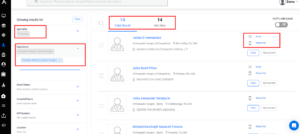The healthcare industry is here to stay- but meeting ever-growing demands for the consumer-minded and aging are loaded with their own set of challenges.
How to overcome the challenges? Virtual Health promises to do that. It is accessible, available, and convenient all around the clock. For decades, virtual health has vowed to be the next disrupter in the delivery of care.
Even though the technological advancement was dramatic, providers, payers, and consumers slowly adopted this virtual health.
Improve Access and Value Through Virtual Health
Health systems have the opportunity to leverage virtual health to magnify their value proposition for consumers in a way to engage more customers, gain their loyalty, and ignite new interactions. Providers may also move ahead to build new possibilities leading to risk-based reimbursement models.
Prior to the COVID-19 pandemic, a healthy system (under a value-based care situation) demonstrated 17% of savings while providing virtual care with their existing healthcare professionals.
On the other hand, providers also have the opportunity to promote efficiency and change capacity use through models like tele-ICU and HaH models, respectively.
Health systems can revamp their strategies and value drivers depending on the growth objectives, market position, and provider capacity.
Get the most up-to-date healthcare commercial intelligence only at Ampliz!
Critical Channel for Health System Volume and Recovery
Virtual health poses threats and opportunities for providers in the healthcare industry because new entrants offer additional virtual access. Providers look to resume care as a part of their clinical and financial strategies.
Virtual Health creates opportunities to attract patients with current services and connections to highly qualified leading providers. Industry leads have already adopted strategic investments with providers offering virtual specialty care across geographical areas traditionally covered by other providers.
The virtual care spread across the geography models sounds attractive to payers if it enables the members to access the lower-cost care settings.
Addressing Needs of Older Patients & Chronic Patients
Besides administering to the broader consumer needs, virtual health is the best tool to leverage for serving older patients and chronic patients. This helps to position the health system for a successful risk-based reimbursement model. The convenience of accessing healthcare from home and reaching out to doctors becomes their primary driver.
Bringing health care closer to patients with the help of virtual health technologies is critical to capturing growth and opportunities because consumers demand highly integrated and accessible care solutions.
Virtual health is a critical element to address following:
- Address to the number of projections
- High utilization, rising cost, and stress on the planet
- Distributed patient geography
Cardi Health shares a similar vision and serves as an excellent example. This tool enables people to monitor and manage heart health effectively. Its features allow to track essential indicators such as heart rate, blood pressure, and cholesterol levels, providing a comprehensive overview of cardiovascular well-being. By analyzing health progress over time, Cardi Health empowers patients to make informed decisions, take proactive steps towards a healthier heart, and conveniently share the progress with healthcare providers.
Preparing for the Tipping Point
Realizing the importance of virtual health in the light of macroeconomic conditions- pushes for automation, quality care, and less spending. As a result, more healthcare stakeholders drive for creating virtual health systems and achieving consistent success. Considering the broader segment of strategic investment, the stakeholders can consider the following realms:
Growth Strategies
Give a thought on the strategies to go beyond telehealth or clinic visit replacement to boost growth among the new populations and in new markets as well as scale other applications.
Innovation & Cost Structure
Start with segmenting the population and specialties whose remote interactions can be measured along with the home-enabling diagnostics and tools.
Nest, reimagine the care with a virtual first mindset and catalyze the sites of careful experimentation. This newly designed model of care acts as a digitally driven capital plan and service delivery model to achieve a reduction in the present cost.
Embed with virtual care settings and acute workflows promotes seamless experience to the providers drive scaling decisions depending upon quantified expertise, quality, efficiency, and financial measures compared to the traditional baseline measures at a physical counter.
Customer Experience and Outcomes
Boost development of a powerful consumer-focused digital experience that acts as a front door for providing patients with seamless digital channels for accessing providers and considering what integrated product covers beyond the current existing features.
Scale your front door by measuring clinical outcomes, access improvement, and providing satisfaction to patients and providers to drive advocacy and contracting for better and expanded coverage.
Physician Alignment
Streamline the provider workforce to support virtual care by building capabilities and incentives for them. Switch the focus to developing continuing education, graduate medical education, and workflow designs. Align the benefit structure for driving the adoption of health systems and physician practice economics.
Technology Infrastructure
Trace the stocks of virtual health applications, systems of engagement and interoperability, and supporting infrastructures. It includes revenue cycle, electronic health record, and digital front door. Design an approach to move to a secure, sustainable, and integrated virtual health platform.
Final Thoughts
Healthcare stakeholders may want to adopt additional buy-in virtual health systems with an intent to boost the quality care and efficiency. Even though providers are bewildered with the strategies to take over, around the challenges posed by COVID-19, aiming to return to new-normal, virtual health provides a valuable framework for fabricating new normal.


